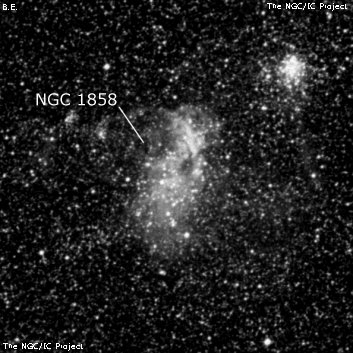
James Dunlop discovered NGC 1858 = D 120 on 3 Aug 1826 with his 9" reflector and described a "small round nebula, about 30" diameter." His position is 14' ESE of this cluster/nebula (association?).
John Herschel missed the earlier observation by Dunlop (not referenced in the CGH catalogue) due to the poor position and independently discovered NGC 1858 = h2784 on 2 Nov 1834, noting "A bright cl of irregular figure." Herschel observed the cluster on no less than 7 sweeps. The next observation was recorded as "a large, irregularly elongated cluster and nebula. Has two bright nebulae N.p." On a third occasion he noted it as "bright, large, irregular figure; binuclear; 3' long, 2' broad. The S.f. of 3." His final observation was recorded as "Two oval nebulae joining." He notes: "This object, by diagrams, made in several of the observations, appears to consist of a resolvable and irresolvable portion, the general form being that of a somewhat crooked oblong extended from N.p. to S.f. at an angle of 60 or 70 degrees with the parallel, the northern end being nebulous, the southern starry. This anomolous form and constitution will serve to explain the apparent disagreement of these descriptions and places."
400/500mm - 18" (7/10/05 - Magellan Observatory, Australia): third of three bright objects in a NW to SE string with NGC 1850 and NGC 1854/55. This is a large and very unusual cluster with nebulosity. There is a bright knot attached near the NW edge, ~15"-20" in diameter. This knot responds very well to a UHC filter at 76x (27 Panoptic). An obvious elongated patch of nebulous haze curves to the SE with several mag 13 stars involved with the glow and extended N-S. Overall, the size of the cluster/nebulosity extends to 3.5'x2'. Located 4.5' SE of NGC 1854.
600/800mm - 24" (4/7/08 - Magellan Observatory, Australia): NGC 1858 would be a fascinating nebula and cluster (association LH 31) even if it was isolated, but it's more striking situated at the southeast end of a wonderful chain with the bright cluster NGC 1854 and NGC 1850, one of the top showpieces in the LMC. At 346x about two dozen stars were superimposed over an elongated glow and many other stars were just outside the glow. At 200x with a UHC filter, the associated emission nebula (LMC-N105) was very bright overall with a very high surface brightness patch (N105A = HD 269111), roughly 30" in size, at the north end. This patch contains the mag 13.9 Wolf-Rayet star Brey 16a = HD 269113. The nebula is brightest along the west and east border and weaker in the center. The elongation is towards a mag 12 star on the south side (Blue supergiant HD 269116). HD 34169, a mag 13.7 star off the west side, is a rare eclipsing binary, consisting of a Wolf-Rayet WN4 star (Brey 16) and an O5-class blue supergiant. The nebulosity forms part of a Superbubble. NGC 1854 lies 4.5' NW.
Notes by Steve Gottlieb